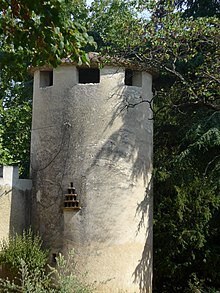Espeluche
|
Espeluche Espelucha |
||
|---|---|---|
|
|
||
| region | Auvergne-Rhône-Alpes | |
| Department | Drôme | |
| Arrondissement | Nyons | |
| Canton | Montélimar-2 | |
| Community association | Montélimar agglomeration | |
| Coordinates | 44 ° 31 ' N , 4 ° 49' E | |
| height | 106-425 m | |
| surface | 11.33 km 2 | |
| Residents | 1,064 (January 1, 2017) | |
| Population density | 94 inhabitants / km 2 | |
| Post Code | 26780 | |
| INSEE code | 26121 | |
 Espeluche - Renaissance house with Banc de Justice |
||
Espeluche ( Occitan : Espelucha ) is a southern French city and a municipality with 1,064 inhabitants (at January 1, 2017) in the department of Drôme in the region Auvergne Rhône-Alpes . The hamlets of Lalo and Saint-Romain also belong to the municipality .
location
The place Espeluche is located in the hilly landscape in the southwest of the Drôme department at an altitude of approx. 160 m ; the next larger city, Montélimar , is about 10 km (driving distance) to the northwest.
Population development
| year | 1800 | 1851 | 1901 | 1954 | 1999 | 2016 |
|---|---|---|---|---|---|---|
| Residents | 462 | 717 | 483 | 332 | 752 | 1039 |
The population decline in the first half of the 20th century is largely due to the loss of jobs as a result of the mechanization of agriculture . The population increase in recent decades, on the other hand, is related to the relative proximity to the city of Montélimar and the significantly lower property prices in the countryside.
economy
The inhabitants of the place lived for centuries as a self-sufficiency from agriculture (agriculture and cattle breeding). Wine was also grown; the place still has the right to market its grapes through the Appellations Comtés Rhodaniens , Mediterranée and Drôme ; There are still vineyards in the vicinity of the village, but there are no longer any vintners in the village. Since the last decades of the 20th century, tourism has played an important role in the economic life of the place in the form of renting holiday apartments ( gîtes ) .
history
During the construction of the TGV route, traces of a Neolithic settlement from around 5000 BC were found in the municipality . Discovered. Bronze Age and Gallo-Roman finds have also been made.
In the Middle Ages, the area belonged to the bishop and crusader Adhemar de Monteil († 1098). However, the existence of today's place has only been documented since the 14th century - at that time there was a priory of Cluny Abbey , which was founded in the Middle Ages, but which soon disappeared again. From that time until the French Revolution , the village , which was provided with a city wall ( remparts ) in the 16th century and spared from the turmoil of the wars of religion , belonged to the Vesc family .
Attractions
- Below the archway of a Renaissance house with a stone cross-frame window in the center of the village is a so-called Banc de Justice - a rare testimony to the case law in the late Middle Ages and early modern times. It has been recognized as a Monument historique since 1981 .
- The simple, single-nave parish church dates from the 18th century and was restored at the beginning of the 21st century.
- outside
- The Château de Lalo is a castle from the 16th century that has been rebuilt and expanded several times. It is privately owned and has been partially recognized as a Monument historique since 1981 . Some items of equipment (mainly paintings) are listed separately.
literature
- Michèle Bois and Chrystèle Burgard: Les châteaux de la Drôme. Fortifications et Palais Éditions Le Dauphiné Libéré, 2007, ISBN 978-2-916272-17-7 .
Web links
Individual evidence
- ↑ Espeluche - Viticulture
- ^ Maison, Espeluche in the Base Mérimée of the French Ministry of Culture (French)
- ↑ Château de Lalo, Espeluche in the Base Mérimée of the French Ministry of Culture (French)
- ^ Château de Lalo, Inventaire

